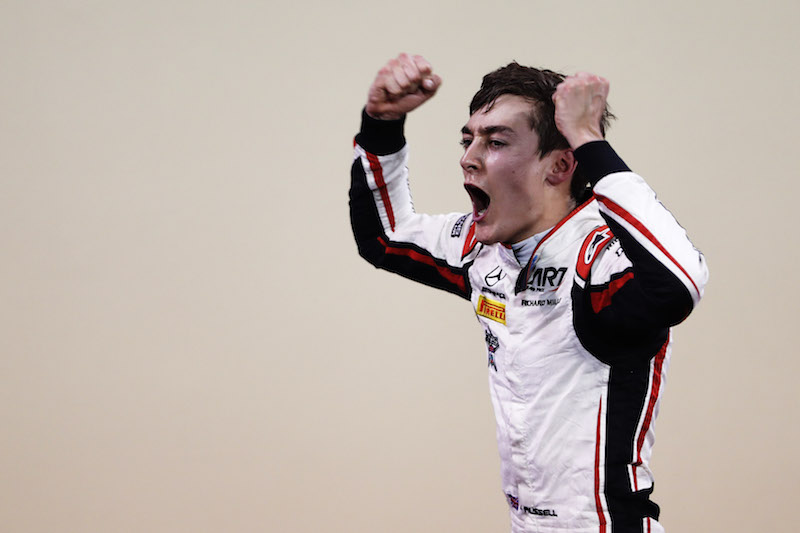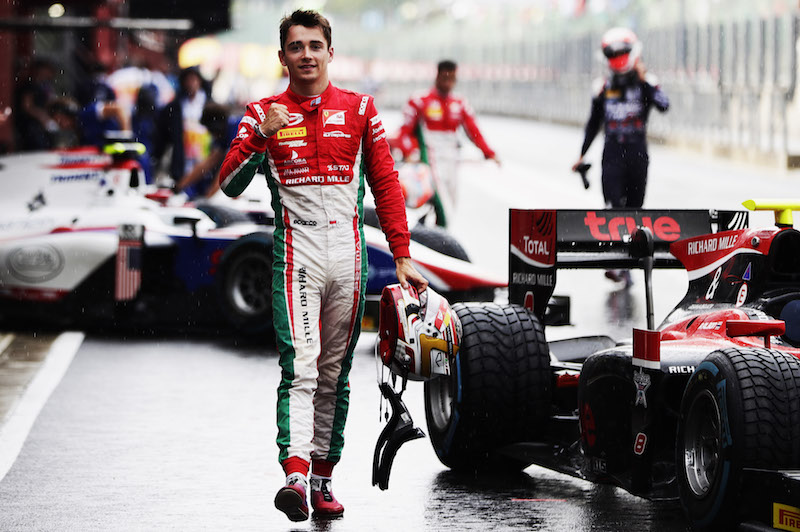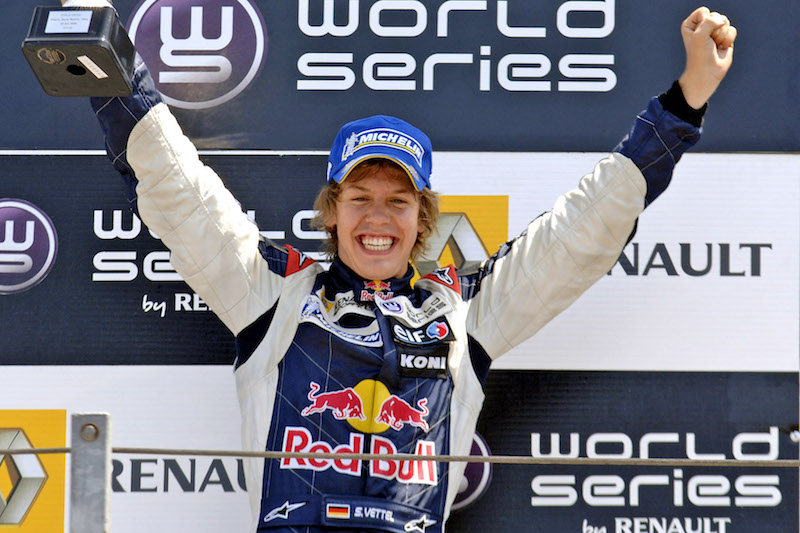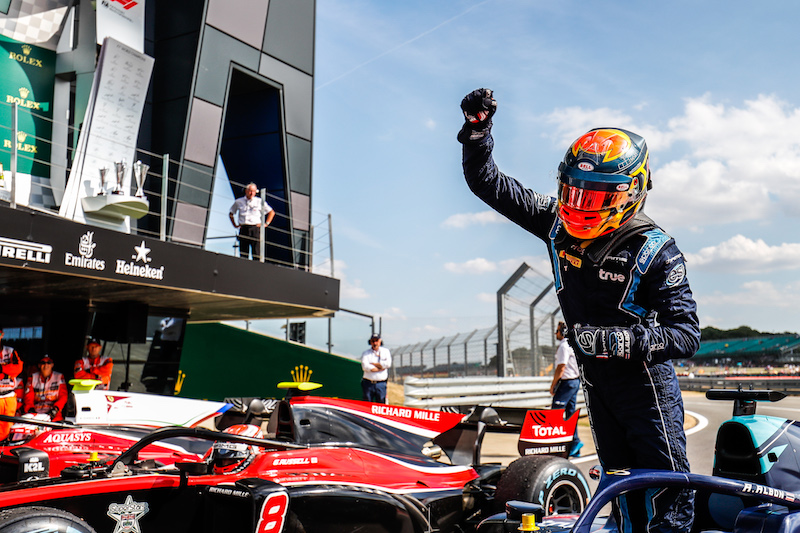Recapping the junior careers of Formula 1’s 2022 grid, aided by photos of the drivers in their racing youth
MERCEDES-AMG
Lewis Hamilton was already a Formula 1 junior during his karting years, last millennium, and the support of McLaren took him from the international scene through to single-seaters in Formula Renault 2.0, Formula 3 and GP2. He started off in FR2.0 UK with Manor Motorsport and took his first win at Thruxton. He added another two wins during the season, but was more impressive in the Eurocup where he had the highest scoring rate of anyone in his part-season and was fifth in the points.
A second season resulted in a dominant UK title and the first F3 appearances for Hamilton, all with Manor, and in 2004 he was reunited with karting rival Nico Rosberg in the F3 Euro Series. It was the German who came out on top, but Hamilton ended the year with a rapid showing in the Macau Grand Prix and a stunning win in the Bahrain Superprix. A falling out followed with his McLaren boss Martin Whitmarsh, who tore up Hamilton’s contract when he and his father pushed for a move up to GP2.
A few weeks later Hamilton re-signed with McLaren after agreeing to another year in F3. A switch to Frederic Vasseur’s ASM/ART Grand Prix operation resulted in back-to-back titles in the Euro Series and GP2, and despite some testing struggles on Michelin tyres he was promoted to a McLaren seat in F1 immediately after. The rest is history.
Noted for his maturity from a young age, it was still difficult for George Russell to get noticed by F1. Highly-rated in karting where he won back-to-back European titles, his first year in cars was split between BRDC British Formula 4 and FR2.0 abroad, and it was the former where he won his first title. But it was the latter where he more frequently raised eyebrows, especially when a change of teams resulted in a Eurocup win.
He was in European F3 the next year, winning his second race but claiming just two other podiums. His second season was better, and with a less experienced team, and while he was overpowered by Stroll in the title race, Mercedes recognised his potential and signed him up. Working with F1’s top team unlocked a new level of performance, and Russell brushed off unreliability to become GP3 and F2 champion with ART. He then sweet-talked Williams into handing him an F1 seat.
SCUDERIA FERRARI
In the face of frequent tragedy, Charles Leclerc was a wanted talent in every series he raced in, guided by established F1 driver manager Nicolas Todt since a glittering karting career. It was Fortec Motorsports that won out to run him in FR2.0 Alps as a single-seater rookie, when he was the best driver bar veteran Nyck de Vries, even on wildcard appearances in a packed Eurocup field.
That earned him a move to FIA European F3 with Van Amersfoort Racing, where some early wins and displays of wet weather ability initially put him in title contention, and despite a lengthy podiumless run afterwards he was signed by the Ferrari Driver Academy. That preceded a GP3 move with ART, which resulted in the title, and he was the class of the Formula 2 field with Prema a year later despite his fair share of bad luck.
Carlos Sainz Jr arrived in single-seaters during Formula BMW Europe’s ultra-competitive final season in 2010, and his rookie crown raised the stakes for the Red Bull protege. What followed was initially just as slick, winning the FR Northern European Cup and finishing second in the Eurocup. On moving up to F3, he again demonstrated the talent he’d inherited from his world rally champion father with four wet-weather wins in the British series, but underwhelmed at other times.
Red Bull moved him to GP3, where he struggled badly, finishing 10th in the points when team-mate Daniil Kvyat won the title straight out of FR2.0. Confidence-boosting Formula Renault 3.5 cameos with Zeta Corse led to a full-time switch to the series with DAMS, and he dominated the 2014 season. His F1 chance only came however when Sebastian Vettel left Red Bull for Ferrari, leaving a vacant Toro Rosso space.
RED BULL RACING
There’s not much to say about Max Verstappen‘s junior single-seater career, beyond it redefining what was expected of young drivers of the present day. The World Karting champion debuted in America in the Ferrari Driver Academy-organised Florida Winter Series, where he was up against some of F3’s finest. He took fastest lap in his first race, was on pole for his third, and a winner by his sixth.
This put expectation on him for European F3 with VAR, having shunned debuting in FR2.0 instead, and he delivered. After winning six races in a row and Masters of F3 he became a Red Bull junior and then days later an F1 driver. Having come third in the European standings, he ended his single year in the junior ranks with seventh in Macau from the back of the grid after crashing out of the qualifying race.
It wasn’t until his fifth year in single-seaters that Sergio Perez took an overall win, having spent his formative years dabbling in A1GP and the secondary class of British F3 as well as the more regular entry-level series. In F3 he did win the title though, and he stuck with the underdog T-Sport team for a season in the primary class where he won a respectable four races, regularly leading the championship before fading late on.
Wins in his debut GP2 Asia campaign that followed was false promise for the main series he stepped up to with Christian Horner’s Arden team, but his sophomore season featured five wins and the title runner-up spot against some quality but inconsistent opposition, earning his F1 break with Sauber and some Ferrari ties.
McLAREN
No other driver this century has had as successful a start to a single-seater career than Lando Norris, with an incredible five titles in his first three seasons. Following a circuit-learning Ginetta Junior campaign alongside his world championship-winning final year in karts, Norris started off with the British F4 title, as well as successful cameos in the German and Italian series.
He used his backing to contest a total of 61 races the following year, winning the Toyota Racing Series in New Zealand and then two FR2.0 titles in Europe, as well as four BRDC British F3 races in a part-season. In 2017 came his first role with McLaren and the European F3 crown – the first for Carlin after six years of Prema domination – and a sixth title just went amiss in his single year in F2.
Daniel Ricciardo raced in Australia, East Asia, Italy, the UK and across Europe for three years with little to show before a driver shootout propelled him into Red Bull’s books and top equipment. He started life as an F1 junior with the FR2.0 West European Cup title and a close second place to Bottas in the Eurocup, and followed it up with a romp to the British F3 title against an admittedly underpar field.
The step up to FR3.5 was therefore a truer test of his ability, and he came just two points short of title glory there too against series veteran Mikhail Aleshin. He returned to the series part-time the following year – winning the Monaco race for the second year in succession – working it around F1 practice outings before Red Bull found him a race seat at HRT.
ALPINE
Spotted by the late Adrian Campos in karts, Fernando Alonso was brought under his wing on a three-year plan. He debuted in FR3.5 predecessor Euro Open by Nissan in 1999 aged 17 and won on his debut weekend, adding five more wins and a title earned on dropped scores before moving to GP2 predecessor International Formula 3000.
Results were lacking at first, but Alonso jumped to fourth in the points with a first win in the final race at Spa. He was an F1 tester for Minardi too, and got a race seat there in his third year in single-seaters. He moved on to Renault with success, and returned there last year under its new name.
F1 had a close eye on Esteban Ocon from karting, when he was picked up by the Gravity management company tied to the Lotus team. His first year of car racing was actually way short of what was expected, but he picked up his game after that and succeeded a race-winning year in FR2.0 in 2013 with an era-defining European F3 title against Tom Blomqvist and Verstappen in 2014.
That crowning moment coincided with the tightening of belts by Lotus ownership, but Mercedes helped him into GP3 where he won another title, thanks this time to consistency more than speed. Then he was moved into the DTM for half a season prior to his F1 debut.
ALPHATAURI
Pierre Gasly raced only for French operations during his first three years in cars, which started with wins in French F4 that earned him some early attention from Red Bull. His rookie Eurocup season wasn’t enough to retain that initial support, but he somewhat unexpectedly won the title the following year, leading Red Bull to sign him outright to its junior team as he made the natural step up to FR3.5.
This marked the start of a lengthy winless spell. He was runner-up in FR3.5 with eight podiums, and took four podiums and three poles in GP2 a year later. Over 1000 days after his last victory, he escaped a road accident to win a GP2 race at Silverstone in 2016, and adding three more won him the title but not an F1 seat. Only an astonishing Super Formula campaign, in which only a typhoon denied him a shot at the title, was able to do that.
After tasting Japanese F4 in 2016, Yuki Tsunoda committed to the series in 2017 as well as contesting the more mechanically complex JAF Japan F4 series. He became grand champion in the latter, but also finished third in the FIA series. Focusing solely on Japanese F4 for 2018 lifted him further and he became Honda’s first champion.
Making the move to Europe, Tsunoda was placed in FIA F3 and Euroformula as a Red Bull junior for 2019, and his racecraft was brilliant in both. He won with a less-fancied team in FIA F3, and was rewarded with promotion to F2, where he surprised by fighting for the title and earning his 2021 F1 seat.
ASTON MARTIN
Like Hamilton, Sebastian Vettel is one of a rare few drivers that have been guided to F1 by a team all the way from karting. It was Red Bull who spotted Vettel’s talent, also very early in his career in the previous millennium, and he made the transition to cars locally in FBMW. It took him two attempts to dominate the ADAC championship, and he only found success in F3 once moving to ASM – by which point he was already an F1 test driver with BMW Sauber.
It was Vettel’s cameos that really caught in the eye in the lower formula, including Macau, Spanish F3 and FR3.5. In 2007 he was set for a full campaign in the latter, and was leading the championship with Carlin before he was plucked away into F1 with BMW Sauber and then Toro Rosso.
Lance Stroll won almost from the off in single-seaters and had Ferrari support from the off too, having been signed to its academy at the age of 11. His presence was almost certainly key to the creation of the Florida Winter Series and he showed well there before gliding to the Italian F4 title, where the combined might of Prema and Ferrari helped considerably with a brand new car.
Winning the TRS title a few months later, in similarly easy fashion, meant more of the same was expected in European F3. Against a talent-stacked field that was not the case as a rookie, especially when it came to his wheel-to-wheel form, which earned him plenty of critics after two significant crashes. He was still fifth in the points though, and he dominated his sophomore season while preparing with Williams to step up to F1. On the side, he also starred in a prototype in the Daytona 24 Hours.
ALFA ROMEO
Valtteri Bottas had most of his junior series success with ART GP, as he won the Masters of F3 race twice and the GP3 title with the team. His early experience came in FR2.0 too, and he won Europe’s two biggest titles in 2008 with Motopark Academy, whose boss Timo Rumpfkeil orchestrated backing from Bottas’s future F1 chief Toto Wolff as well as Mika Hakkinen.
His second F3 season coincided with a shift in power from ART and Mercedes to Signature and Volkswagen, meaning he missed out on the Euro Series title. Hence the move to GP3, where he went from 10th in the points to champion after four wins in the final four rounds. Bottas’s F1 break didn’t come through a GP2 campaign, instead earning a promotion from test driver at Williams following a year out of racing.
China’s first F2 racer Zhou Guanyu benefited from Ferrari and Renault/Alpine backing prior to jumping into an Alfa Romeo seat this year alongside the team’s other new signign Bottas, and he’s entering F1 with one single-seater title to his name.
In 2021 he won the Formula Regional Asian Championship with Abu Dhabi Racing by Prema in between his second and third seasons in F2 with Virtuosi Racing. That title success earned him additional FIA superlicence points that were crucial for strengthening his bargaining hand in F1 silly season, and three wins in the first half of the F2 season helped him further.
His end position in the championship was third, an improvement on his previous two seasons, and also showing that he was able to be an equal to the more highly-touted drivers on the grid.
Prior to his F2 blossoming, Zhou claimed two wins from three years in European F3, was a TRS race-winner and perhaps most impressively was Italian F4 runner-up in his first full year racing cars.
HAAS
Efforts were made to hide Mick Schumacher‘s family connection early in his career to avoid media pressure, but his karting results, as well as Deutsche Vermögensberatung sponsorship, marked him out. VAR provided Schumacher with his first single-seater berth in F4, and winning in his first ever weekend suggested he would be one to watch. But the reversed-grid victory proved to be a false dawn for the rookie, and only found the pace and consistency needed in his second season.
That was the same in other series Schumacher entered: runner-up in ADAC and Italian F4, third in the MRF Challenge and winning the European F3 title in his sophomore season. Ferrari picked him up after that, and developed him over two years of F2 into an F1-worthy talent.
A late change means there’s no Nikita Mazepin alongside Schumacher, but instead Kevin Magnussen returns to the team after a year out racing in IMSA and IndyCar after he was replaced by Mazepin.
Magnussen followed a similar junior series path to his father Jan, also a former F1 driver, as he won the Danish Formula Ford title then after coming second in FR2.0 NEC went to race in F3. He was third in Germany as a rookie, then after some bad luck with engine issues was able to be runner-up to Felipe Nasr in the British championship in 2011 while also starring in European appearances.
He was a McLaren F1 junior by this point, and the team entered him into FR3.5 for his next step. A thought-provoking first season with Carlin, which did include a win, led him to working even harder and then obliterating the field through much of 2013 with DAMS. Those performances were enough to convince McLaren he was worthy of an F1 seat the next year.
WILLIAMS
A late start to karting, and a sideline in Porsches, are two of the oddities of Nicholas Latifi‘s pre-F1 path, and he has only got stronger with each category he has moved on to. He had an unconventional start in Italian F3, where he did win, then took the only poles of his racing career in British F3.
Seasons in European F3 and FR3.5 didn’t show signs of race-winning form, but upon making it to GP2 with DAMS he began to settle down. He finished second in his first race with the team, after imperious testing form, and finished fifth in the points in his second full season. Illness and a new car to learn held him back in 2018, but he did add another win and started the 2019 season on fire before his title campaign ran out of steam.
Despite a lack of titles, Alex Albon now has one of the most well-known paths to F1 in the modern era due to his early dropping by Red Bull and then invitation back to the brand in 2019 when it was in search of a driver to race for Toro Rosso.
The Thai started straight away in FR2.0, and a points-free Eurocup campaign led to him losing his Red Bull junior status. He still had enough money to race in the series, and on his return picked up a pole and four points finishes in 2013.
Another jump in performance put him third in the 2014 points, although he only had three podiums, and in the NEC he picked up his first car racing win. Joining a revived Signature team in European F3 was an inspired move for Albon’s next step, as he earned pole positions and podiums in a field stacked with future F1 talents.
There was no return for a title attack though, as he moved to GP3 with a plum ART GP seat and challenged Leclerc for the 2016 title. The team kept him for his move up to F2 the next year, but a training accident meant he missed a round and endured a difficult campaign. His budget was also not in place for a second season, and he did find a seat at DAMS for 2018 but only on a round-by-round basis. Three poles and a win in the first four rounds helped him secure a full-time berth, and the results he put in after then earned him a top Formula E seat with Nissan e.dams before Red Bull stole him for F1.



















